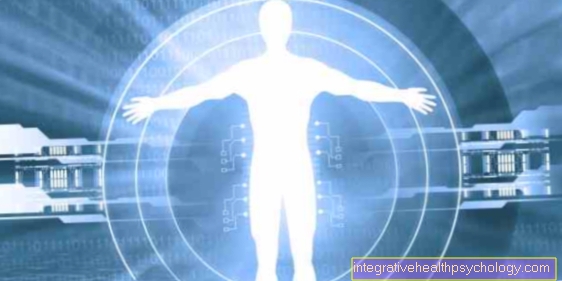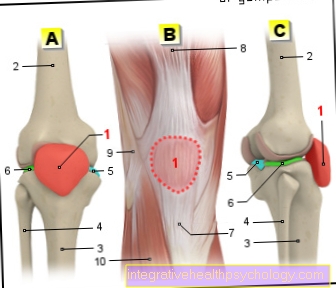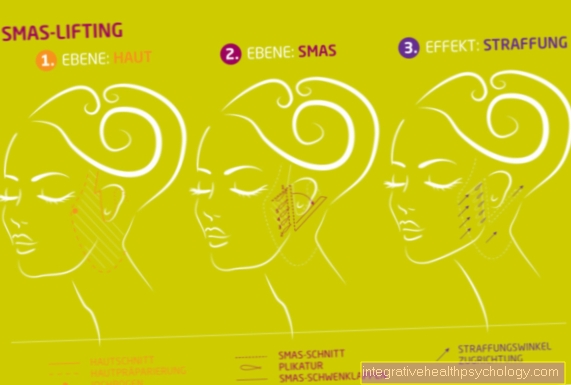Flank pain on both sides
Flank pain on both sides is understood to be pain on the left and right in the area of the lateral trunk. For those affected, this means that the discomfort exists in the area that they can move from the ribs to the pelvic shovel with one hand when grasping the side wall of the trunk. It is typical for flank pain that it radiates into the back, which those affected can often perceive as a pulling into the lumbar area.
Learn what is causing left-sided such as right flank pain could be.

Where is flank pain exactly?
The flank is defined as the area of the lateral fuselage wall. So if those affected stand straight in front of a mirror and place their hand about a hand's breadth under the nipple on the side of the upper abdominal region and flatter the curve from the front to the back, they are at the upper attachment of the flank region. Let your hand slide down to the pelvic shovel, you will reach the lower area of the flank region.
It is important to know that the flank is really only located in the "turn-up area" from the front to the back and in a narrow strip of the adjacent back.The area of approx. 5 cm to the left and right of the spine is therefore excluded from flank pain.
Causes of bilateral flank pain
There are not many causes for bilateral flank pain, as structures or organs that are paired in the body must be affected for a bilateral occurrence. So actually only nerves, muscles and the kidneys with the associated ureters are considered as triggers for bilateral flank pain.
Muscle tension is a disproportionately common cause. Above all the "Musculus latissimus dorsi" - which is sometimes responsible for the mobility of the lumbar spine - often causes pain.
If acute and colic-like pain occur, this is more likely to indicate a build-up of urine in the kidneys.
Diseases of the intestine
Diseases of the intestine are rather uncharacteristic of bilateral flank pain. In principle, they would be conceivable because intestinal parts can be found in both flank regions, but pain in intestinal complaints is more diffuse in the area of the abdomen or only in one side region.
In individual cases, however, imaging must be carried out to clarify the cause of the symptoms.
Kidney disease
Flank pain is typical of kidney diseases. However, bilateral flank pain is relatively rare. They suggest a condition that affects both kidneys, as can occur in the case of ascending infection or urinary obstruction. For both kidneys to become symptomatic, however, it must be a fulminant finding. If the pain occurs on both sides, the severity of the disease is to be assessed as high and requires immediate medical clarification and treatment.
Find out more about Pain in the kidney area.
Occurrence after exercise
Flank pain on both sides after exercise suggests overuse of the back muscles. The result is a symmetrical sore muscles in the flank area, whereby exercises such as pull-ups or training on a rowing machine can cause the pain.
With physical rest for a few days, the pain usually disappears quickly.
Flank pain on both sides during pregnancy
If bilateral flank pain occurs during pregnancy, it is often due to a muscular problem. As the waistline grows, an imbalance develops in terms of the load on the spine - the additional weight practically pulls you forward. Reactively, the lumbar spine and sacrum are more stressed. The muscles attached to this are also under a changed tension as a result. Since this also lasts permanently, the muscles often harden and ultimately become painful.
Pregnant women can lie down in phases to relieve the strain or do light exercises to relax the muscles.
How is the diagnosis made?
The diagnosis of bilateral flank pain is made through a thorough physical exam. It is best for the examining doctor to sit down on a stool with the patient's back turned towards him and let the patient's upper body free. With the outer edge of the hand, he then taps the entire flank region as far as the pain of the person concerned allows. Flank pain occurs when the shock caused by the light blow triggers abnormal sensations - regardless of whether it is stabbing, pulsating or dull - in this area. Bilateral pain is often almost identical to the opposite side in terms of intensity and the affected area.
If there is a suspicion of a disease of the kidneys or the ureters, further imaging should always take place.
Concomitant symptoms
Accompanying symptoms of bilateral flank pain depend very much on their cause.
- In the case of muscle tension or hardening, back pain and restricted mobility often occur.
- If the cause is in the kidneys, urination problems and fever may also occur.
- In the case of nerve irritation, those affected often describe shooting pain similar to an electric shock.
nausea
Nausea is often an unconscious response to severe pain. So if it occurs in combination with bilateral flank pain, it speaks for a fulminant disease.
However, flank pain is often incorrectly stated when there is a disease of the pancreas. If this is irritated, it can cause belt-shaped pain up to the back in combination with nausea. In contrast to flank pain, however, the pain typically runs on a horizontal level in the area of the trunk and does not pull down along the side wall.
Back pain
Back pain is very often confused with flank pain. However, those affected can easily tell them apart with the help of small tests. If the person concerned can point to the painful area with the finger or the whole hand, back pain is located in a strip of about five centimeters to the left and right of the spine, regardless of the movement performed. However, if the pain is more on the envelope from the front to the back, it is flank pain.
Read the Difference between kidney and back pain to.
Flatulence
Flatulence is not the cause of bilateral flank pain, as irritation of the intestine due to excessive gas filling mainly causes diffuse abdominal pain. Those affected therefore feel pain especially in the palm-sized area around the navel. In addition, a round, spherical belly is often an indication that the intestinal loops are too full of gas. However, the flanks are typically not painful. Pain in the area of the left flank would only be conceivable if the terminal part of the intestine was excessively filled shortly before the intestinal gases left.
Tension
Flank pain on both sides can certainly occur together with tension. The tension arises as a result of permanent tensing of the muscles as a result of an unphysiological relieving posture due to pain, which leads to over-acidification of this. As a result, the muscle can no longer relax and those affected notice this from a noticeable hardening of the muscle.
Warmth and targeted exercises can help with a purely muscular problem, whereas in the case of an inflammatory cause, usually only targeted drug treatment can provide relief.
How do you treat bilateral flank pain?
The therapy of bilateral flank pain depends entirely on its cause.
Muscular problems above all require physiotherapeutic treatment. Their aim must be to correct a bad posture or relieve posture and to practice exercises that can be carried out independently by the person affected as a prevention. In the case of very pronounced muscle tension, drug-based pain therapy can be used temporarily as a support.
If you have kidney problems, it is important to first clarify what the exact cause is.
Inflammatory processes often require the use of antibiotics combined with painkillers and, not infrequently, inpatient monitoring in the hospital.
If there is a build-up of urine due to a mechanical obstacle, such as in the case of advanced tumor growth, the tumor must be eliminated.
Treatment by a physiotherapist can usually help with nervous problems. However, if nerves are compressed by other structures, they must be relieved by manual or surgical maneuvers.
Duration / forecast
Usually, bilateral flank pain subsides quickly after treating the cause. In the case of muscular problems, a clear relief should set in after 2-3 days, while in the case of infectious processes in the kidneys, a persistence of the symptoms of up to a week can be expected and complete recovery can take up to about two weeks. In general, however, any bilateral flank pain should decrease in intensity over time. A renewed increase in pain indicates a relapse.
Disease progression of bilateral flank pain
The course of the disease in bilateral flank pain can vary greatly depending on the individual and the cause of the disease. In addition, it depends on the cause whether complete healing is possible or whether residuals or functional losses are to be expected.
Muscular problems are usually indicated by slowly increasing pain and, with adequate treatment, decrease slowly and continuously.
If urine build-up is the trigger, the pain will immediately decrease significantly as soon as the obstruction is removed. The more severe the degree of congestion, the more likely permanent kidney damage is to be expected.
Infectious causes are usually expressed as colicky or stabbing pain, which clearly diminishes in intensity in the course of drug treatment.





























